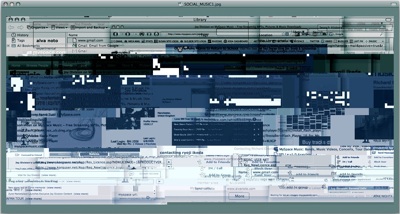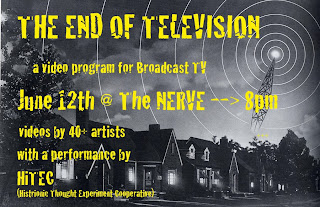 Drawing influence from both contemporary DJ culture and the Fluxus musicial traditions of artists like Ben Vautier and John Cage, SOCIAL [net.work music] is a new improvised network sound project and performance which utilizes the MySpace Music social network as its core sound library.
Drawing influence from both contemporary DJ culture and the Fluxus musicial traditions of artists like Ben Vautier and John Cage, SOCIAL [net.work music] is a new improvised network sound project and performance which utilizes the MySpace Music social network as its core sound library.
Recently, I’ve been interested in the the aural connections created through the MySpace Music social network. By navigating the “Friends Space” link section on each member’s page, reminiscent of web 1.0 webrings, the user can access an interconnected network of each artists influences, friends and label mates, allowing them to discover new artists and different genres of music. Most of the pages feature a jukebox with samples of the musicians work which automatically begin to play once the page has finished loading.
The SOCIAL [net.work music] project and performance begins on my own MySpace Music page. I select at random an artist from my “Friends Space” list and allow the page to load. Once the music begins to play, i select a friend link from that artist’s list and open the page in a new tab. This permits the music to layer over top of the previous track. The process continues until, eventually from the inability to handle the incoming data load, the browser crashes, bringing the composition to an end.
Each performance yields a spontaneous and unique, layered score without the use of sample preparation, sophisticated hardware or software. All of the resulting audio produced in each performance is unedited and live in the moment. These works can be created and performed anywhere at anytime with simply a web browser and internet connection. I sculpt the layered audio on my end with a hacked kaoss pad, to add my own color to the sonic collage.
[Jason Sloan]
Jason Sloan is a new media artist, electronic musician, composer and professor at the Maryland Institute College of Art in Baltimore, Maryland.
Go to SOCIAL [net.work music] to listen.







 At the core of “Suomenlinna Ornithological Society” is the invention of new bird species with electronic birdsongs. The concrete sources of these birdsongs are samples taken from a Suomenlinna museum film about the history of the island. Explosions, cannonball whistles, and grisly vocal narrations are re-shaped into the rhythms, timbres and frequencies of birdsong. This transformation references the Electronic Voice Phenomenon (EVP), a supposedly paranormal occurrence where voices of the dead are heard via electronic technology.
At the core of “Suomenlinna Ornithological Society” is the invention of new bird species with electronic birdsongs. The concrete sources of these birdsongs are samples taken from a Suomenlinna museum film about the history of the island. Explosions, cannonball whistles, and grisly vocal narrations are re-shaped into the rhythms, timbres and frequencies of birdsong. This transformation references the Electronic Voice Phenomenon (EVP), a supposedly paranormal occurrence where voices of the dead are heard via electronic technology.

 Il 12 Giugno 2009 le ultime TV americane che trasmettevano in analogico hanno spento per sempre i loro trasmettitori, passando al digitale.
Il 12 Giugno 2009 le ultime TV americane che trasmettevano in analogico hanno spento per sempre i loro trasmettitori, passando al digitale.
 Questa incredibile costruzione Art Deco di 26 piani, con tanto di aquile che le danno un aspetto quasi neo gotico, si trova a San Francisco ed è vuota.
Questa incredibile costruzione Art Deco di 26 piani, con tanto di aquile che le danno un aspetto quasi neo gotico, si trova a San Francisco ed è vuota.


